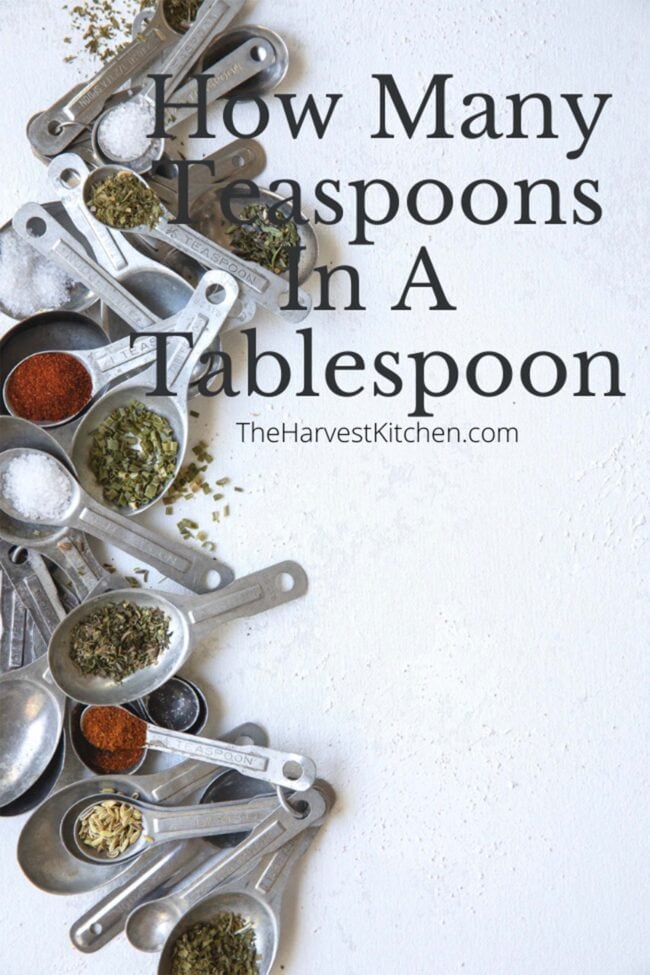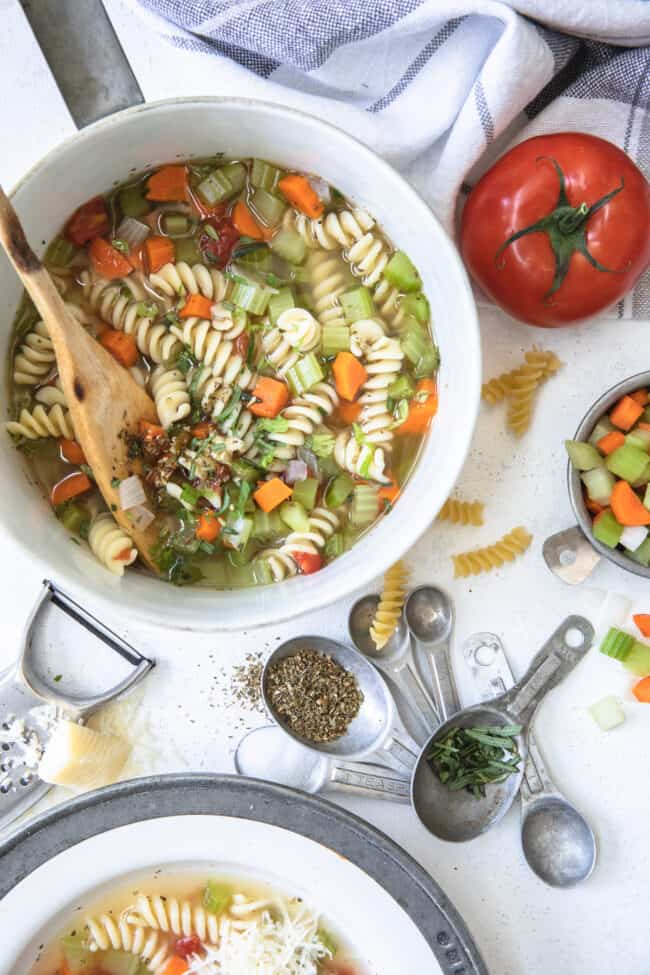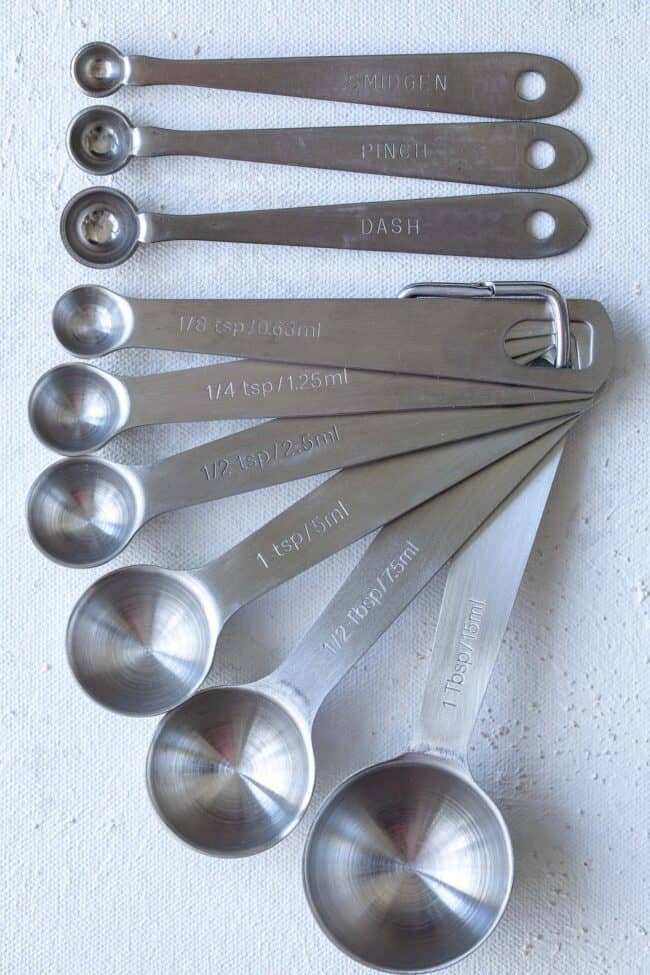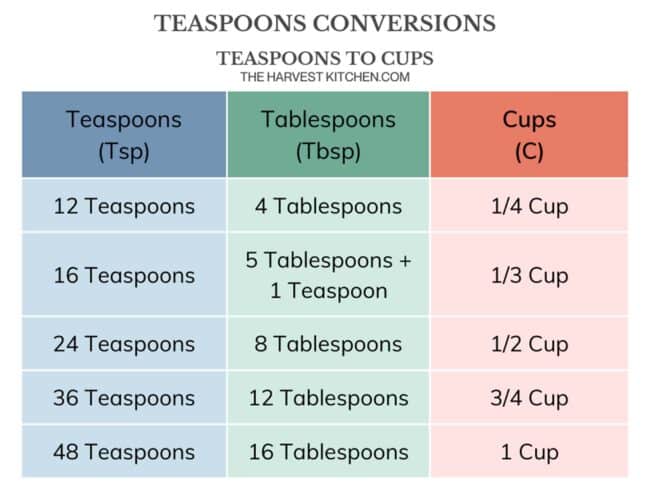How Many Teaspoons in a Tablespoon
Need to know How Many Teaspoons in a Tablespoon? Here’s everything you need to know about how to convert teaspoons to tablespoons (tsp to tbsp or tbsp to tsp). What is a teaspoon and what is a tablespoon. I’ve also provided you with an easy conversion chart below to help you memorize these conversions.

Being successful in the kitchen requires the accurate measurement of ingredients. When following recipes to make a meal, you might be able to eyeball the amount of herbs and spices and other simple ingredients, but if you add too much or too little of an ingredient, the outcome of your recipe might not be what you had hoped for. Knowing how many teaspoons in a tablespoon is a helpful liquid measurement conversion to have memorized for achieving success in the kitchen.
Cooking and baking can be very rewarding when the recipe turns out! Knowing how many teaspoons are in a tablespoon (tsp to tbsp) is helpful for you to achieve success in the kitchen.
How Many Teaspoons Are in a Tablespoon (tsp to tbsp)
These are some basic conversions that are good know (like tsp to tbsp), especially if you spend a lot of time cooking and baking.
How Many teaspoons in a tablespoon (tsp to tbsp)? There are 3 teaspoons in 1 tablespoon.
- 3 teaspoons = 1 tablespoon
- 6 teaspoons = 2 tablespoons
- 9 teaspoons = 3 tablespoons
What is a Teaspoon
The teaspoon is a common measurement of ingredients used in cooking and baking.
Teaspoon is equivalent to 0.16 fluid ounce, 1/3 of a tablespoon or 5 mL. A teaspoon is abbreviated in recipes as “tsp,” “tsps” or just the lower case “t”. Teaspoons are used to measure dry ingredients like dried herbs and spices, baking powder, baking soda and cream of tartar. They can also be used to measure liquids like pure vanilla extract, honey, maple syrup, mustard and mayonnaise.
What is a Tablespoon
The tablespoon is a common measurement of ingredients used in cooking and baking.
Tablespoon is equivalent to 0.5 fluid ounce or 15 mL. A tablespoon is commonly abbreviated in recipes as “tbsp” or “tbs”. Similar to the teaspoon, a tablespoon is used to measure dry ingredients like dried herbs and spices, baking powder, baking soda and cream of tartar. It can also be used to measure liquids like pure vanilla extract, honey, maple syrup, mustard and mayonnaise.
What’s a Pinch, Dash and Smidgen
Even though the obscure measurements of a pinch, dash and smidgen are so small that they are unlikely to make any really difference in the outcome of your recipe, they do in fact have actual concrete sizes. You can purchase measuring spoons for dash, pinch and smidgen and take the guesswork out things for the next time you need a pinch of salt, nutmeg or some other ingredient.
How much is a tad?
A tad is 1/4 teaspoon
How much is a dash?
A dash is 1/8 teaspoon and is typically used for liquid ingredients
How much is a pinch?
A pinch is 1/16 teaspoon, and in theory the dry ingredient should fit between your thumb and forefinger.
How much is a smidgen?
A smidgen is 1/32 teaspoon
How much is a drop?
A drop is 1/64 teaspoon, and is used for liquid ingredients
Liquid Measurement Chart
It’s helpful to know some simple kitchen conversions when you’re needing to adjust a recipe whether its to double it or cut the amount in half. Knowing these simple conversions will help you adjust measurements in a recipe so you can achieve the desired results.
Imperial (US) System vs Metric System
Different countries use different volume and weight measurements. Some countries use the Imperial System while some use the Metric System.
The United States still uses the Imperial System for measurements (which was developed and used in the United Kingdom around 1826), where most countries like the United Kingdom, Australia, Canada have since adopted the metric system using measurements like grams, meters, liters, kilograms and kilometers. There aren’t significant differences in volume between the Imperial (US) and Metric measuring systems.
For the most part, the Metric System has replaced the imperial system in countries who once used it. The United States is one of the few countries in the world who has yet to switch to the Metric System of measurements. But if you’re in a pinch, if a recipe is written using the Metric system, you can easily use US teaspoons and tablespoons to convert to metric measurements.
Converting US Standard to Metric System [Approximate Measurements]
- 1 US tablespoon (Imperial tablespoon) = 1/2 fluid ounce (14.79 milliliters) and 1 UK and Canada Metric tablespoon = 15 milliliters.
- 1 US teaspoon (Imperial teaspoon) = 1/6 fluid ounce (4.93 milliliters) and 1 UK and Canada Metric teaspoon = 5 milliliters
The US Customary System
The United States Customary System (U.S. Customary System) is a system of weights and measures used in the United States and some other countries. This system includes units for measuring length (inches, feet, yards and miles), weight (ounce, pound, ton), and capacity (teaspoons, tablespoon, cups, pints, quarts, gallons.
Tips to Measure Like a Pro
- A good rule of thumb is to use a dry measuring cup or a tablespoon when measuring dry ingredients, use a liquid measuring cup when measuring liquids.
- Use a kitchen scale when you need to measure your ingredients by weight.
Measuring Dry Ingredients
It’s always a good idea to carefully read the recipe before measuring ingredients. If a recipe calls for chopped ingredients (like onion, shallots or nuts), you would chop the ingredients first before measuring them.
- Dry ingredients can compact over time, so it’s best to use a tablespoon or a fork to fluff it up a bit before scooping it up with your measuring cup. You always want dry ingredients like flour and brown sugar to be light and fluffy when measuring them (unless a recipe calls for packed brown sugar).
- Fill dry ingredients such as flour and sugar to the brim of the measuring cup, and scrape away the excess from the top using the back of a knife.
- Make sure your measuring cups are sitting level on the counter before measuring ingredients
- When measuring a tablespoon, the tablespoons should also be level to ensure a precise measurement. Give the tablespoon a little tap on the counter to make the ingredient as level as possible. Use your forefinger to scrape across the top of the measuring spoon to remove the excess.
- If your recipe calls for a “heaping tablespoon”, then include more of the dry ingredient piled on top of the tablespoon.
- Measure dry ingredients over a piece of waxed paper or parchment to make cleanup easier.
- Never “pack” flour like you would brown sugar.
Measuring Liquid Ingredients
- When measuring liquids, make sure the measuring cup is sitting level on the counter. Then squat down to eyeball the measurement line to make sure you have the precise measurement.
- Some wet ingredients like yogurt, sour cream don’t settle precisely in a liquid measuring cup, so you can spoon the ingredient into dry measuring cups. Tap the cup on the counter to help settle and remove air pockets before leveling the top with the back of a knife.




